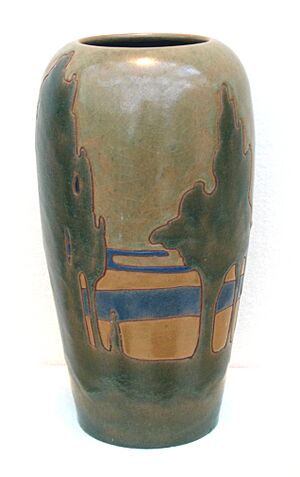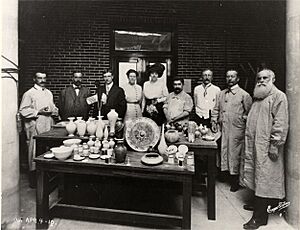Frederick Hurten Rhead facts for kids
Frederick Hurten Rhead (1880–1942) was a famous ceramic artist. He was a big part of the Arts and Crafts movement. Born in England, he spent most of his career as a potter in the United States.
Rhead taught pottery skills and was important in both small art studios and large pottery factories. He worked for Roseville Pottery and started his own company, Rhead Pottery (1913–1917). In 1935, he designed the very popular Fiesta ware for the Homer Laughlin China Company. Today, Rhead's artwork is shown in major art museums.
Contents
Early Life and Education
Frederick Rhead was born in Hanley, England. His family had been potters for a long time. His father, Frederick Alfred Rhead, learned to be an artist at Mintons Ltd. Frederick's mother, Adolphine, also came from an artistic family.
Frederick had siblings who were also artists. His sister, Charlotte Rhead, became a talented designer in England. His brother, Harry Rhead, later joined Frederick to work in the United States.
Frederick went to school in Hanley, England. He learned pottery skills from his father in Burslem. He also took classes at the Wedgwood Institute. After finishing school, Rhead taught art in Longton. He then became the art director at a pottery company called Wardle and Co. His sister Charlotte also worked there.
Career in the USA
In 1902, Frederick Hurten Rhead moved to the United States. His uncle, Louis Rhead, was already a successful graphic designer in New York. Many potters from England moved to places like Trenton, New Jersey, or Ohio. These areas had good clay for making pottery.
Rhead's first job in the USA was managing a small art pottery in Tiltonville, Ohio. It was called Avon Faience. Pieces from this time are very rare today. In 1904, Rhead became the art director at Roseville Pottery in Zanesville, Ohio. Roseville was a large company that made both art pottery and everyday items. In 1909, Rhead moved to University City, Missouri.
University City Pottery
In University City, Rhead taught at the People's University, Missouri. He worked with other famous potters like Adelaide Alsop Robineau and Taxile Doat. This school offered distance learning courses, which meant students could learn from home. Rhead created a pottery course for these students. Some students also lived at the Art Academy.
Rhead made some beautiful vases and tiles while at University City. He sometimes worked with his wife, Agnes. In 2012, a special four-tile panel made by Rhead sold for $637,500 at an auction. This panel, showing a peacock, was made in 1910. It was bought for the Museum of the American Arts and Crafts Movement.
Working in California
After University City, Rhead moved to Marin County, California. He worked at the Arequipa tuberculosis sanatorium starting in 1911. The sanatorium offered pottery classes to patients. Rhead had big plans for the Arequipa Pottery. He found good clays and experimented with different glazes. He also taught a decorating method called tubelining.
In 1913, Rhead started his own pottery studio in Santa Barbara. This studio operated until 1917. The pottery made during this time is now very valuable. In 2007, a Rhead vase from this period set a record for the most expensive American art pottery sold at auction.
Return to Ohio
Later in his career, Rhead worked on larger, more commercial pottery projects. He returned to Zanesville, Ohio, and worked for the American Encaustic Tiling Company. This company made encaustic tiles, which are decorative floor tiles. They also made many everyday tiles. American Encaustic was once the largest tile factory in the world. It closed in the 1930s because of the Great Depression.
Designing Fiesta Ware
In 1927, Rhead became the art director for the Homer Laughlin China Company in Newell, West Virginia. He stayed in this job until he passed away in 1942.
In the 1930s, Rhead designed a line of colorful dinnerware called Fiesta. It had a round, modern look, like Art Deco style. The pottery came in five bright colors. The idea was that people could buy pieces in different colors and mix and match them.
Fiesta ware was introduced in January 1936 and became an instant hit. The idea of mixing solid colors for dinnerware wasn't new, but Rhead's design was the most successful. The Homer Laughlin Company added new shapes and colors to the line. Fiesta ware became the best-selling dinnerware in the United States. Rhead also designed a similar line called "Harlequin," which was sold at Woolworth's.
Frederick Hurten Rhead died in New York City in November 1942 from cancer.
Legacy and Impact
Rhead was important in two different areas: making unique art pottery and designing for large factories. His art pottery is displayed in major American museums, including the Metropolitan Museum of Art. His American work can sell for very high prices.
His most famous achievement might be the mass-produced Fiesta designs. The Fiesta line has been made since 1936, though not continuously. After Rhead's death, making Fiesta ware became difficult during World War II. The United States government took control of all available uranium to make the atomic bomb. Uranium oxide was needed to create the bright orange-red glaze for Fiesta. Without this key color, and with fewer items available, the line became less popular.
Sales of Fiesta ware slowly went down over the next 27 years. The entire line was stopped in January 1973. However, after 13 years, Fiesta ware was brought back in 1986. This was to celebrate the 50th anniversary of the original line. Also, people were starting to like vintage designs again. Some of Rhead's original molds were even used to make the new Fiesta ware.



